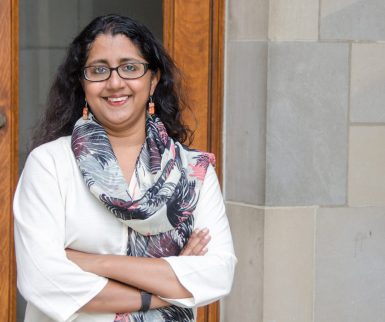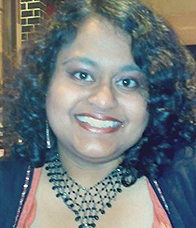Parameswaran, Rao analyze news outlet/archive dedicated to rural India
The online People’s Archive of Rural India extensively documents the lives of everyday rural Indians, but research by professor Radhika Parameswaran and doctoral candidate Pallavi Rao raises questions about who this content serves.

Parameswaran and Rao presented their research Friday in a research colloquium talk. “Rural India’s Virtual/Visual Archive: Mapping the Material and Aesthetic Contours of an ‘Insane’ Digital Intervention,” discussed both the content and the visual presentation of the site, which serves as both an archive and journalistic engine dedicated to telling the stories of rural India’s 833 million residents.
Parameswaran and Rao were critical of some of the website’s choices, but also recognized the value in some of PARI’s work.
The website’s creator creator, Palagummi Sainath — a prominent Indian journalist — framed the project as a resource that could eventually be an all-encompassing archive of rural India.
But one of the pair’s primary critiques was that the website is predominantly in the English language.
“It’s about the rural, but it’s targeting a more transnational audience,” Parameswaran said.
Sainath also emphasizes that the website is separate from both governmental and corporate control.
However, the website cannot be completely independent from the government, Parameswaran and Rao argued. For example, many of the sources listed on the Resources page originate from the government.
“While he distances himself from the government’s financial apparatus, he embraces the government’s information-gathering apparatus,” Parameswaran said.
So although the website is not funded by the government, it does rely on state-sponsored research and survey information.

This separation from both state and corporate power allows the website to influence both those spheres.
“PARI operates very much as a third space, as a part of civil society,” Parameswaran said.
Parameswaran and Rao pointed to a fellowship program Sainath created as an example of this independence. This program trains the people who are being covered, such as women and minorities, to be journalists themselves and contribute to the website’s content.
Rao focused mainly on the website’s visual and aesthetic decisions. For example, the website’s home page features a large slideshow of photographs.
“The function of that slideshow is to really give you examples of stories from across India,” Rao said.
The archive is interdisciplinary and incorporates various mediums. Along with journalism and photography, it houses documentary work, oral histories, folklore and visual anthropology.
“That work of rural journalism is present on the website in contemporary ways,” Rao said.
These different ways of portraying rural India did create some confusion for Parameswaran and Rao, they said.
In particular, they pointed to the Faces section of the website as potentially problematic.
“It is meant to show India has a kind of facial diversity, which we find kind of strange,” Rao said. “What we find troubling is that viewers are invited to imagine these regions as particular types of faces, and we aren’t quite sure what conclusions the viewers are meant to draw from that.”
Overall, Parameswaran and Rao spoke about both the limits and possibilities of this type of web-based archive.
“The vision the website is presenting is that the rural are victimized, they are disenfranchised, but they are not victims,” Parameswaran said. “This is a social justice model, not a savior model.”

